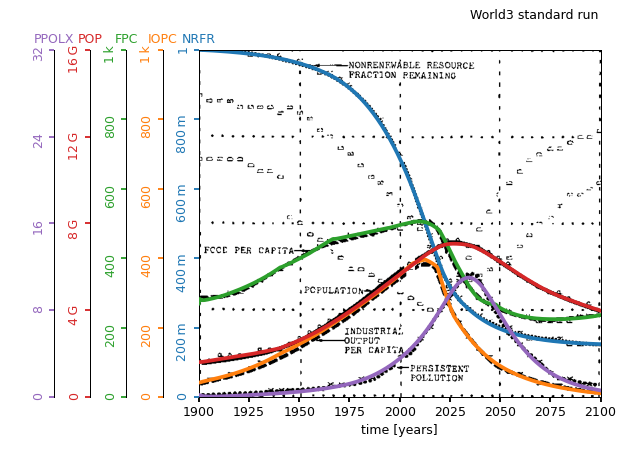The World3 model revisited in Python
PyWorld3 was updated to the 2004 version PyWorld3-03 with the original STELLA version of the book "Limits to Growth: The 30-year update". PyWorld3-03 has been verified with the original simulation. Not all functionalities have been implemented. See original PyWorld3 (https://github.com/cvanwynsberghe/pyworld3).
PyWorld3 is a Python implementation of the World3 model, as described in the book Dynamics of Growth in a Finite World. This version slightly differs from the previous one used in the world-known reference the Limits to Growth, because of different numerical parameters and a slightly different model structure.
The World3 model is based on an Ordinary Differential Equation solved by a Backward Euler method. Although it is described with 12 state variables, taking internal delay functions into account raises the problem to the 29th order. For the sake of clarity and model calibration purposes, the model is structured into 5 main sectors: Population, Capital, Agriculture, Persistent Pollution and Nonrenewable Resource.
Install and Hello World3
Install pyworld3 by cloning the repository, installing the requirements numpy, scipy
and matplotlib and do:
python setup.py install
Run the provided example to simulate the standard run, known as the Business as usual scenario:
import pyworld3
pyworld3.hello_world3()As shown below, the simulation output compares well with the original print. For a tangible understanding by the general audience, the usual chart plots the trajectories of the:
- population (
POP) from the Population sector, - nonrenewable resource fraction remaining (
NRFR) from the Nonrenewable Resource sector, - food per capita (
FPC) from the Agriculture sector, - industrial output per capita (
IOPC) from the Capital sector, - index of persistent pollution (
PPOLX) from the Persistent Pollution sector.
How to tune your own simulation
One simulation requires a script with the following steps:
from pyworld3 import World3
world3 = World3() # choose the time limits and step.
world3.init_world3_constants() # choose the model constants.
world3.init_world3_variables() # initialize all variables.
world3.set_world3_table_functions() # get tables from a json file.
world3.set_world3_delay_functions() # initialize delay functions.
world3.run_world3()You should be able to tune your own simulations quite quickly as long as you want to modify:
- time-related parameters during the instantiation,
- constants with the
init_world3_constantsmethod, - nonlinear functions by editing your modified tables
./your_modified_tables.jsonbased on the initial json filepyworld3/functions_table_world3.jsonand callingworld3.set_world3_table_functions("./your_modified_tables.json").
Licence
The project is under the CeCILL 2.1 licence, a GPL-like licence compatible with international and French laws. See the terms for more details.
References and acknowledgment
- Vanwynsberghe, Charles. PyWorld3 - The World3 model revisited in Python, 2021
- Meadows, Dennis L., William W. Behrens, Donella H. Meadows, Roger F. Naill, Jørgen Randers, and Erich Zahn. Dynamics of Growth in a Finite World. Cambridge, MA: Wright-Allen Press, 1974.
- Meadows, Donella H., Dennis L. Meadows, Jorgen Randers, and William W. Behrens. The Limits to Growth. New York 102, no. 1972 (1972): 27.
- Markowich, P. Sensitivity Analysis of Tech 1-A Systems Dynamics Model for Technological Shift, (1979).


